Estimation and Change Analysis of Grassland AGB in the China–Mongolia–Russia Border Area Based on Multi-Source Geospatial Data
Abstract
1. Introduction
2. Materials
2.1. Study Area
2.2. Data Sources and Preprocessing
2.2.1. MODIS Data
2.2.2. AGB Observation Data
3. Methods
3.1. AGB Estimation
3.1.1. SHAP Feature Importance Analysis
3.1.2. AGB Estimation Model
3.1.3. Accuracy Assessment
3.2. AGB Time Series Analysis
3.2.1. Past Trends in AGB Change
3.2.2. Pattern of AGB Change
3.2.3. Future Dynamics of AGB Change
- (1)
- To define the time series (t), t = .
- (2)
- To calculate the mean of the AGB time series,
- (3)
- To calculate the accumulated deviation,
- (4)
- To acquire the level difference,
- (5)
- To acquire the standard deviation sequence,
- (6)
- To acquire the H exponent,
4. Results
4.1. AGB Estimation Model
4.1.1. Feature Importance Analysis Based on SHAP
4.1.2. AGB Estimation Accuracy Assessment
4.1.3. Comparison of Estimated Spatial Distribution of AGB
4.2. Change Trend in Grassland AGB over the Past 21 Years
4.3. Change Pattern in Grassland AGB over the Past 21 Years
4.4. Future AGB Trend Change
5. Discussion
5.1. AGB Estimation Model
5.2. AGB Past and Future Changes
5.3. Limitations and Improvements
6. Conclusions
- (1)
- The integration of SHAP-based feature selection and RF_PSO significantly enhances both the accuracy and interpretability of AGB inversion in transboundary grassland ecosystems. This is evidenced by the superior performance of the proposed model compared to five baseline methods (ElasticNet, PCR, PLSR, SVR, and BR), achieving the highest accuracy with R2 0.87 and the lowest RMSE, demonstrating both effective feature relevance and robust optimization.
- (2)
- The incorporation of temporal trajectory clustering offers a novel perspective on long-term spatiotemporal patterns, facilitating the early identification of ecosystem transitions. Trajectory clustering revealed four dominant AGB temporal patterns—Fluctuating Low, Stable Low, Fluctuating High, and Stable High—with notable shifts occurring in 2007, 2012, and 2014, indicating key ecological transitions and differentiating stable versus unstable areas.
- (3)
- In this paper, a scalable analytical framework was established for detecting patterns of ecological degradation, resilience, and uncertainty in fragile borderland environments. Trend and persistence analysis showed that 58.17% of the region exhibited improving trends, while 41.56% experienced degradation (notably in CN_NMG and MN_CE). Hurst exponent results further revealed that 80% of the area is likely to maintain its current trajectory, 13% may reverse, and 7% shows uncertainty—supporting targeted management strategies.
Supplementary Materials
Author Contributions
Funding
Data Availability Statement
Conflicts of Interest
References
- Bai, Y.; Cotrufo, M.F. Grassland soil carbon sequestration: Current understanding, challenges, and solutions. Science 2022, 377, 603–608. [Google Scholar] [CrossRef] [PubMed]
- Midgley, G.F.; Bond, W.J. Future of African terrestrial biodiversity and ecosystems under anthropogenic climate change. Nat. Clim. Change 2015, 5, 823–829. [Google Scholar] [CrossRef]
- Wang, J.; Zhang, A.; Shi, J.; Kang, X.; He, N.; Gao, X.; Pang, H. A novel remote sensing method for monitoring Large-Scale grassland aboveground Biomass: The case study of grassland key belt in the Tibetan Plateau. Ecol. Indic. 2024, 169, 112890. [Google Scholar] [CrossRef]
- Naidoo, L.; van Deventer, H.; Ramoelo, A.; Mathieu, R.; Nondlazi, B.; Gangat, R. Estimating above ground biomass as an indicator of carbon storage in vegetated wetlands of the grassland biome of South Africa. Int. J. Appl. Earth Obs. Geoinf. 2019, 78, 118–129. [Google Scholar] [CrossRef]
- Li, X.; Zhang, X.; Xu, X. Precipitation and anthropogenic activities jointly green the China–Mongolia–Russia economic corridor. Remote Sens. 2022, 14, 187. [Google Scholar] [CrossRef]
- Li, J.; Dong, S.; Li, Y.; Wang, Y.; Li, Z.; Li, F. Effects of land use change on ecosystem services in the China–Mongolia–Russia economic corridor. J. Clean. Prod. 2022, 360, 132175. [Google Scholar] [CrossRef]
- Li, J.; Dong, S.; Li, Y.; Wang, Y.; Li, Z.; Wang, M. Environmental governance of transnational regions based on ecological security: The China-Mongolia-Russia Economic Corridor. J. Clean. Prod. 2023, 422, 138625. [Google Scholar] [CrossRef]
- Rahman, M.S. The Belt and Road Initiative: Geo-strategically its Impact and Implications for the Region of South Asia. Contemp. Res. Interdiscip. Acad. J. 2024, 7, 153–173. [Google Scholar] [CrossRef]
- Wang, Z.; Deng, X.; Song, W.; Li, Z.; Chen, J. What is the main cause of grassland degradation? A case study of grassland ecosystem service in the middle-south Inner Mongolia. Catena 2017, 150, 100–107. [Google Scholar] [CrossRef]
- Liu, Y.; Zhang, Z.; Tong, L.; Khalifa, M.; Wang, Q.; Gang, C.; Wang, Z.; Li, J.; Sun, Z. Assessing the effects of climate variation and human activities on grassland degradation and restoration across the globe. Ecol. Indic. 2019, 106, 105504. [Google Scholar] [CrossRef]
- Zhang, M.; Ma, X.; Chen, A.; Guo, J.; Xing, X.; Yang, D.; Xu, B.; Lan, X.; Yang, X. A spatio-temporal fusion strategy for improving the estimation accuracy of the aboveground biomass in grassland based on GF-1 and MODIS. Ecol. Indic. 2023, 157, 111276. [Google Scholar] [CrossRef]
- Lucas, R.; Van De Kerchove, R.; Otero, V.; Lagomasino, D.; Fatoyinbo, L.; Omar, H.; Satyanarayana, B.; Dahdouh-Guebas, F. Structural characterisation of mangrove forests achieved through combining multiple sources of remote sensing data. Remote Sens. Environ. 2020, 237, 111543. [Google Scholar] [CrossRef]
- Zhang, Y.; Ma, J.; Liang, S.; Li, X.; Li, M. An evaluation of eight machine learning regression algorithms for forest aboveground biomass estimation from multiple satellite data products. Remote Sens. 2020, 12, 4015. [Google Scholar] [CrossRef]
- Carreiras, J.M.; Vasconcelos, M.J.; Lucas, R.M. Understanding the relationship between aboveground biomass and ALOS PALSAR data in the forests of Guinea-Bissau (West Africa). Remote Sens. Environ. 2012, 121, 426–442. [Google Scholar] [CrossRef]
- Feng, H.; Fan, Y.; Yue, J.; Bian, M.; Liu, Y.; Chen, R.; Ma, Y.; Fan, J.; Yang, G.; Zhao, C. Estimation of potato above-ground biomass based on the VGC-AGB model and deep learning. Comput. Electron. Agric. 2025, 232, 110122. [Google Scholar] [CrossRef]
- Wang, Z.; Wang, J.; Wang, W.; Zhang, C.; Mandakh, U.; Ganbat, D.; Myanganbuu, N. An Explanation of the Differences in Grassland NDVI Change in the Eastern Route of the China–Mongolia–Russia Economic Corridor. Remote Sens. 2025, 17, 867. [Google Scholar] [CrossRef]
- Ghosh, S.S.; Khati, U.; Kumar, S.; Bhattacharya, A.; Lavalle, M. Gaussian process regression-based forest above ground biomass retrieval from simulated L-band NISAR data. Int. J. Appl. Earth Obs. Geoinf. 2023, 118, 103252. [Google Scholar] [CrossRef]
- Yu, S.; Ye, Q.; Zhao, Q.; Li, Z.; Zhang, M.; Zhu, H.; Zhao, Z. Effects of driving factors on forest aboveground biomass (AGB) in China’s Loess Plateau by using spatial regression models. Remote Sens. 2022, 14, 2842. [Google Scholar] [CrossRef]
- Wu, Z.; Yao, F.; Zhang, J.; Liu, H. Estimating Forest Aboveground Biomass Using a Combination of Geographical Random Forest and Empirical Bayesian Kriging Models. Remote Sens. 2024, 16, 1859. [Google Scholar] [CrossRef]
- Mukhopadhyay, R.; Kumar, S.; Aghababaei, H.; Kulshrestha, A. Estimation of aboveground biomass from PolSAR and PolInSAR using regression-based modelling techniques. Geocarto Int. 2022, 37, 4181–4207. [Google Scholar] [CrossRef]
- Yue, J.; Feng, H.; Yang, G.; Li, Z. A comparison of regression techniques for estimation of above-ground winter wheat biomass using near-surface spectroscopy. Remote Sens. 2018, 10, 66. [Google Scholar] [CrossRef]
- Li, H.; Kai, L.; Banghui, Y.; Shudong, W.; Yu, M.; Dacheng, W.; Xingtao, L.; Long, L.; Dehui, L.; Yong, B.; et al. Continuous monitoring of grassland AGB during the growing season through integrated remote sensing: A hybrid inversion framework. Int. J. Digit. Earth 2024, 17, 2329817. [Google Scholar] [CrossRef]
- Zhu, X.; Liu, D. Improving forest aboveground biomass estimation using seasonal Landsat NDVI time-series. ISPRS J. Photogramm. Remote Sens. 2015, 102, 222–231. [Google Scholar] [CrossRef]
- Tian, X.; Yan, M.; van der Tol, C.; Li, Z.; Su, Z.; Chen, E.; Li, X.; Li, L.; Wang, X.; Pan, X. Modeling forest above-ground biomass dynamics using multi-source data and incorporated models: A case study over the qilian mountains. Agric. For. Meteorol. 2017, 246, 1–14. [Google Scholar] [CrossRef]
- Güneralp, İ.; Filippi, A.M.; Randall, J. Estimation of floodplain aboveground biomass using multispectral remote sensing and nonparametric modeling. Int. J. Appl. Earth Obs. Geoinf. 2014, 33, 119–126. [Google Scholar] [CrossRef]
- Yang, H.; Ciais, P.; Santoro, M.; Huang, Y.; Li, W.; Wang, Y.; Bastos, A.; Goll, D.; Arneth, A.; Anthoni, P. Comparison of forest above-ground biomass from dynamic global vegetation models with spatially explicit remotely sensed observation-based estimates. Glob. Change Biol. 2020, 26, 3997–4012. [Google Scholar] [CrossRef] [PubMed]
- Xie, J.; Wang, C.; Ma, D.; Chen, R.; Xie, Q.; Xu, B.; Zhao, W.; Yin, G. Generating Spatiotemporally Continuous Grassland Aboveground Biomass on the Tibetan Plateau Through PROSAIL Model Inversion on Google Earth Engine. IEEE Trans. Geosci. Remote Sens. 2022, 60, 1–10. [Google Scholar] [CrossRef]
- Zhang, X.; Shen, H.; Huang, T.; Wu, Y.; Guo, B.; Liu, Z.; Luo, H.; Tang, J.; Zhou, H.; Wang, L.; et al. Improved random forest algorithms for increasing the accuracy of forest aboveground biomass estimation using Sentinel-2 imagery. Ecol. Indic. 2024, 159, 111752. [Google Scholar] [CrossRef]
- Silveira, E.M.; Silva, S.H.G.; Acerbi-Junior, F.W.; Carvalho, M.C.; Carvalho, L.M.T.; Scolforo, J.R.S.; Wulder, M.A. Object-based random forest modelling of aboveground forest biomass outperforms a pixel-based approach in a heterogeneous and mountain tropical environment. Int. J. Appl. Earth Obs. Geoinf. 2019, 78, 175–188. [Google Scholar] [CrossRef]
- Ge, J.; Hou, M.; Liang, T.; Feng, Q.; Meng, X.; Liu, J.; Bao, X.; Gao, H. Spatiotemporal dynamics of grassland aboveground biomass and its driving factors in North China over the past 20 years. Sci. Total Environ. 2022, 826, 154226. [Google Scholar] [CrossRef] [PubMed]
- Deb, D.; Deb, S.; Chakraborty, D.; Singh, J.; Singh, A.K.; Dutta, P.; Choudhury, A. Aboveground biomass estimation of an agro-pastoral ecology in semi-arid Bundelkhand region of India from Landsat data: A comparison of support vector machine and traditional regression models. Geocarto Int. 2022, 37, 1043–1058. [Google Scholar] [CrossRef]
- Zeng, N.; Ren, X.; He, H.; Zhang, L.; Li, P.; Niu, Z. Estimating the grassland aboveground biomass in the Three-River Headwater Region of China using machine learning and Bayesian model averaging. Environ. Res. Lett. 2021, 16, 114020. [Google Scholar] [CrossRef]
- Emick, E.; Babcock, C.; White, G.W.; Hudak, A.T.; Domke, G.M.; Finley, A.O. An approach to estimating forest biomass while quantifying estimate uncertainty and correcting bias in machine learning maps. Remote Sens. Environ. 2023, 295, 113678. [Google Scholar] [CrossRef]
- Morais, T.G.; Teixeira, R.F.M.; Figueiredo, M.; Domingos, T. The use of machine learning methods to estimate aboveground biomass of grasslands: A review. Ecol. Indic. 2021, 130, 108081. [Google Scholar] [CrossRef]
- Smith, P.; Soussana, J.-F.; Angers, D.; Schipper, L.; Chenu, C.; Rasse, D.P.; Batjes, N.H.; van Egmond, F.; McNeill, S.; Kuhnert, M.; et al. How to measure, report and verify soil carbon change to realize the potential of soil carbon sequestration for atmospheric greenhouse gas removal. Glob. Change Biol. 2020, 26, 219–241. [Google Scholar] [CrossRef] [PubMed]
- Zhao, Y.; Zhang, L.; Lei, S.; Liao, L.; Zhang, C. Machine learning-based prediction of belowground biomass from aboveground biomass and soil properties. Environ. Model. Softw. 2025, 185, 106313. [Google Scholar] [CrossRef]
- Jiang, F.-G.; Li, M.-D.; Chen, S.-W. Adaptive Gaussian-PSO XGBoost Model for Alpine Forests Aboveground Biomass Estimation Using Spaceborne PolSAR and LiDAR Data. IEEE J. Sel. Top. Appl. Earth Obs. Remote Sens. 2025, 18, 10157–10171. [Google Scholar] [CrossRef]
- Ha, N.T.; Manley-Harris, M.; Pham, T.D.; Hawes, I. The use of radar and optical satellite imagery combined with advanced machine learning and metaheuristic optimization techniques to detect and quantify above ground biomass of intertidal seagrass in a New Zealand estuary. Int. J. Remote Sens. 2021, 42, 4712–4738. [Google Scholar] [CrossRef]
- Luo, H.; Qin, S.; Li, J.; Lu, C.; Yue, C.; Ou, G. High-density forest AGB estimation in tropical forest integrated with PolInSAR multidimensional features and optimized machine learning algorithms. Ecol. Indic. 2024, 160, 111878. [Google Scholar] [CrossRef]
- Yıldırım, A. Unsupervised classification of multispectral Landsat images with multidimensional particle swarm optimization. Int. J. Remote Sens. 2014, 35, 1217–1243. [Google Scholar] [CrossRef]
- Tian, Y.; Huang, H.; Zhou, G.; Zhang, Q.; Tao, J.; Zhang, Y.; Lin, J. Aboveground mangrove biomass estimation in Beibu Gulf using machine learning and UAV remote sensing. Sci. Total Environ. 2021, 781, 146816. [Google Scholar] [CrossRef]
- Nguyen, T.H.; Jones, S.D.; Soto-Berelov, M.; Haywood, A.; Hislop, S. Monitoring aboveground forest biomass dynamics over three decades using Landsat time-series and single-date inventory data. Int. J. Appl. Earth Obs. Geoinf. 2020, 84, 101952. [Google Scholar] [CrossRef]
- Zhao, L.; Zhou, W.; Peng, Y.; Hu, Y.; Ma, T.; Xie, Y.; Wang, L.; Liu, J.; Liu, Z. A new AG-AGB estimation model based on MODIS and SRTM data in Qinghai Province, China. Ecol. Indic. 2021, 133, 108378. [Google Scholar] [CrossRef]
- Şen, Z.; Şişman, E. Risk attachment Sen’s Slope calculation in hydrometeorological trend analysis. Nat. Hazards 2024, 120, 3239–3252. [Google Scholar] [CrossRef]
- Zhang, J.; Fang, S.; Liu, H. Estimation of alpine grassland above-ground biomass and its response to climate on the Qinghai-Tibet Plateau during 2001 to 2019. Glob. Ecol. Conserv. 2022, 35, e02065. [Google Scholar] [CrossRef]
- Fang, H.; Fan, L.; Ciais, P.; Xiao, J.; Fensholt, R.; Chen, J.; Frappart, F.; Ju, W.; Niu, S.; Xiao, X.; et al. Satellite-based monitoring of China’s above-ground biomass carbon sink from 2015 to 2021. Agric. For. Meteorol. 2024, 356, 110172. [Google Scholar] [CrossRef]
- Wei, P.; Chen, S.; Wu, M.; Jia, Y.; Xu, H.; Liu, D. Increased ecosystem carbon storage between 2001 and 2019 in the northeastern margin of the Qinghai-Tibet plateau. Remote Sens. 2021, 13, 3986. [Google Scholar] [CrossRef]
- Qian, C.; Qiang, H.; Li, M. A novel Multiscale Geographically and Temporally Gravity-Weighted Regression Model: Algorithm Principle and an Application in Assessment of Forest Biomass in Karst Region. IEEE Trans. Geosci. Remote Sens. 2025, 63, 1. [Google Scholar] [CrossRef]
- Nguyen, T.H.; Jones, S.; Soto-Berelov, M.; Haywood, A.; Hislop, S. Landsat Time-Series for Estimating Forest Aboveground Biomass and Its Dynamics across Space and Time: A Review. Remote Sens. 2020, 12, 98. [Google Scholar] [CrossRef]
- Liu, Z.; Long, J.; Lin, H.; Sun, H.; Ye, Z.; Zhang, T.; Yang, P.; Ma, Y. Mapping and analyzing the spatiotemporal dynamics of forest aboveground biomass in the ChangZhuTan urban agglomeration using a time series of Landsat images and meteorological data from 2010 to 2020. Sci. Total Environ. 2024, 944, 173940. [Google Scholar] [CrossRef] [PubMed]
- Lu, D.; Chen, Q.; Wang, G.; Liu, L.; Li, G.; Moran, E. A survey of remote sensing-based aboveground biomass estimation methods in forest ecosystems. Int. J. Digit. Earth 2016, 9, 63–105. [Google Scholar] [CrossRef]
- Gómez, C.; White, J.C.; Wulder, M.A.; Alejandro, P. Historical Forest biomass dynamics modelled with Landsat spectral trajectories. ISPRS J. Photogramm. Remote Sens. 2014, 93, 14–28. [Google Scholar] [CrossRef]
- Heiskanen, J.; Adhikari, H.; Piiroinen, R.; Packalen, P.; Pellikka, P.K. Do airborne laser scanning biomass prediction models benefit from Landsat time series, hyperspectral data or forest classification in tropical mosaic landscapes? Int. J. Appl. Earth Obs. Geoinf. 2019, 81, 176–185. [Google Scholar] [CrossRef]
- Powell, S.L.; Cohen, W.B.; Healey, S.P.; Kennedy, R.E.; Moisen, G.G.; Pierce, K.B.; Ohmann, J.L. Quantification of live aboveground forest biomass dynamics with Landsat time-series and field inventory data: A comparison of empirical modeling approaches. Remote Sens. Environ. 2010, 114, 1053–1068. [Google Scholar] [CrossRef]
- Shi, Y.-Y.; Niu, F.-J.; Jin, H.-J.; You, X.-N.; Lin, Z.-J.; Wang, D.-Y.; Wang, R.-K.; Wu, C.-Y. Evaluation and prediction of engineering construction suitability in the China–Mongolia–Russia economic corridor. Adv. Clim. Change Res. 2023, 14, 166–178. [Google Scholar] [CrossRef]
- Belhadi, A.; Djenouri, Y.; Srivastava, G.; Cano, A.; Lin, J.C.W. Hybrid Group Anomaly Detection for Sequence Data: Application to Trajectory Data Analytics. IEEE Trans. Intell. Transp. Syst. 2022, 23, 9346–9357. [Google Scholar] [CrossRef]
- Qin, Y.; Xiao, X.; Wigneron, J.-P.; Ciais, P.; Canadell, J.G.; Brandt, M.; Li, X.; Fan, L.; Wu, X.; Tang, H.; et al. Large loss and rapid recovery of vegetation cover and aboveground biomass over forest areas in Australia during 2019–2020. Remote Sens. Environ. 2022, 278, 113087. [Google Scholar] [CrossRef]
- Benali, A.; Ervilha, A.R.; Sá, A.C.L.; Fernandes, P.M.; Pinto, R.M.S.; Trigo, R.M.; Pereira, J.M.C. Deciphering the impact of uncertainty on the accuracy of large wildfire spread simulations. Sci. Total Environ. 2016, 569–570, 73–85. [Google Scholar] [CrossRef] [PubMed]
- Marcílio, W.E.; Eler, D.M. From explanations to feature selection: Assessing SHAP values as feature selection mechanism. In Proceedings of the 2020 33rd SIBGRAPI Conference on Graphics, Patterns and Images (SIBGRAPI), Porto de Galinhas, Brazil, 7–10 November 2020; pp. 340–347. [Google Scholar]
- Le, N.Q.K.; Ho, Q.-T.; Nguyen, V.-N.; Chang, J.-S. BERT-Promoter: An improved sequence-based predictor of DNA promoter using BERT pre-trained model and SHAP feature selection. Comput. Biol. Chem. 2022, 99, 107732. [Google Scholar] [CrossRef] [PubMed]
- Liu, Y.; Liu, Z.; Luo, X.; Zhao, H. Diagnosis of Parkinson’s disease based on SHAP value feature selection. Biocybern. Biomed. Eng. 2022, 42, 856–869. [Google Scholar] [CrossRef]
- Daviran, M.; Maghsoudi, A.; Ghezelbash, R. Optimized AI-MPM: Application of PSO for tuning the hyperparameters of SVM and RF algorithms. Comput. Geosci. 2025, 195, 105785. [Google Scholar] [CrossRef]
- Chen, L.; Wang, Y.; Ren, C.; Zhang, B.; Wang, Z. Optimal Combination of Predictors and Algorithms for Forest Above-Ground Biomass Mapping from Sentinel and SRTM Data. Remote Sens. 2019, 11, 414. [Google Scholar] [CrossRef]
- Forkuor, G.; Benewinde Zoungrana, J.-B.; Dimobe, K.; Ouattara, B.; Vadrevu, K.P.; Tondoh, J.E. Above-ground biomass mapping in West African dryland forest using Sentinel-1 and 2 datasets—A case study. Remote Sens. Environ. 2020, 236, 111496. [Google Scholar] [CrossRef]
- Jia, Z.; Zhang, Z.; Cheng, Y.; Buhebaoyin; Borjigin, S.; Quan, Z. Grassland biomass spatiotemporal patterns and response to climate change in eastern Inner Mongolia based on XGBoost model estimates. Ecol. Indic. 2024, 158, 111554. [Google Scholar] [CrossRef]
- Tian, Z.; Yang, W.; Zhang, T.; Ai, T.; Wang, Y. Characterizing the activity patterns of outdoor jogging using massive multi-aspect trajectory data. Comput. Environ. Urban Syst. 2022, 95, 101804. [Google Scholar] [CrossRef]
- Yao, Y.; Ren, H. Estimation of grassland aboveground biomass in northern China based on topography-climate-remote sensing data. Ecol. Indic. 2024, 165, 112230. [Google Scholar] [CrossRef]
- Bo, Y.; Guo, X.; Liu, Q.; Pan, Y.; Zhang, L.; Lu, Y. Prediction of tunnel deformation using PSO variant integrated with XGBoost and its TBM jamming application. Tunn. Undergr. Space Technol. 2024, 150, 105842. [Google Scholar] [CrossRef]
- Meng, B.; Ge, J.; Liang, T.; Yang, S.; Gao, J.; Feng, Q.; Cui, X.; Huang, X.; Xie, H. Evaluation of Remote Sensing Inversion Error for the Above-Ground Biomass of Alpine Meadow Grassland Based on Multi-Source Satellite Data. Remote Sens. 2017, 9, 372. [Google Scholar] [CrossRef]
- Yu, T.; Guli·Jiapaer; Bao, A.; Zhang, J.; Tu, H.; Chen, B.; De Maeyer, P.; Van de Voorde, T. Evaluating surface soil moisture characteristics and the performance of remote sensing and analytical products in Central Asia. J. Hydrol. 2023, 617, 128921. [Google Scholar] [CrossRef]
- Zhang, C.; Yi, Y.; Wang, L.; Zhang, X.; Chen, S.; Su, Z.; Zhang, S.; Xue, Y. Estimation of the bio-parameters of winter wheat by combining feature selection with machine learning using multi-temporal unmanned aerial vehicle multispectral images. Remote Sens. 2024, 16, 469. [Google Scholar] [CrossRef]
- Liu, Y.; Sun, S.; Yang, X.; Wang, X.; Liu, K.; Dong, H. Estimating Biomass Carbon Stocks of Inner Mongolia Grasslands Using Multi-Source Data. Remote Sens. 2025, 17, 29. [Google Scholar] [CrossRef]
- Chen, F.; Guo, F.; Liu, L.; Nan, Y. An Improved Method for Pan-Tropical Above-Ground Biomass and Canopy Height Retrieval Using CYGNSS. Remote Sens. 2021, 13, 2491. [Google Scholar] [CrossRef]
- Yan, N.; Zhu, W.; Wu, B.; Tuvdendorj, B.; Chang, S.; Mishigdorj, O.; Zhang, X. Assessment of the grassland carrying capacity for winter-spring period in Mongolia. Ecol. Indic. 2023, 146, 109868. [Google Scholar] [CrossRef]
- Wang, H.; Kang, C.; Tian, Z.; Zhang, A.; Cao, Y. Vegetation periodic changes and relationships with climate in Inner Mongolia Based on the VMD method. Ecol. Indic. 2023, 146, 109764. [Google Scholar] [CrossRef]
- Qiu, C.; Zhang, C.; Ma, J.; Yang, C.; Wang, J.; Mandakh, U.; Ganbat, D.; Myanganbuu, N. Analysis of Grassland Vegetation Coverage Changes and Driving Factors in China–Mongolia–Russia Economic Corridor from 2000 to 2023 Based on RF and BFAST Algorithm. Remote Sens. 2025, 17, 1334. [Google Scholar] [CrossRef]
- Zhao, Y.; Wang, J.; Zhang, G.; Liu, L.; Yang, J.; Wu, X.; Biradar, C.; Dong, J.; Xiao, X. Divergent trends in grassland degradation and desertification under land use and climate change in Central Asia from 2000 to 2020. Ecol. Indic. 2023, 154, 110737. [Google Scholar] [CrossRef]

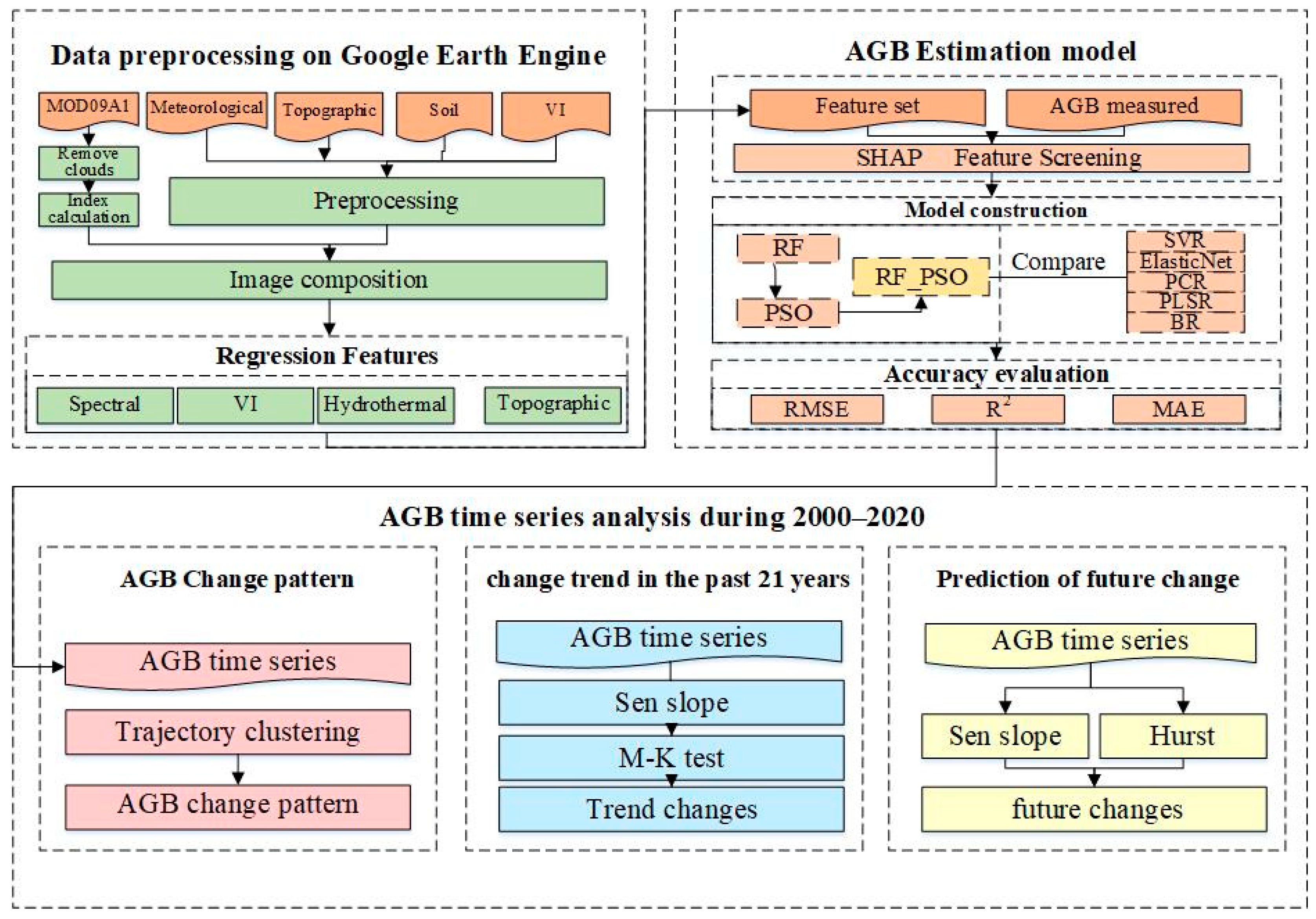
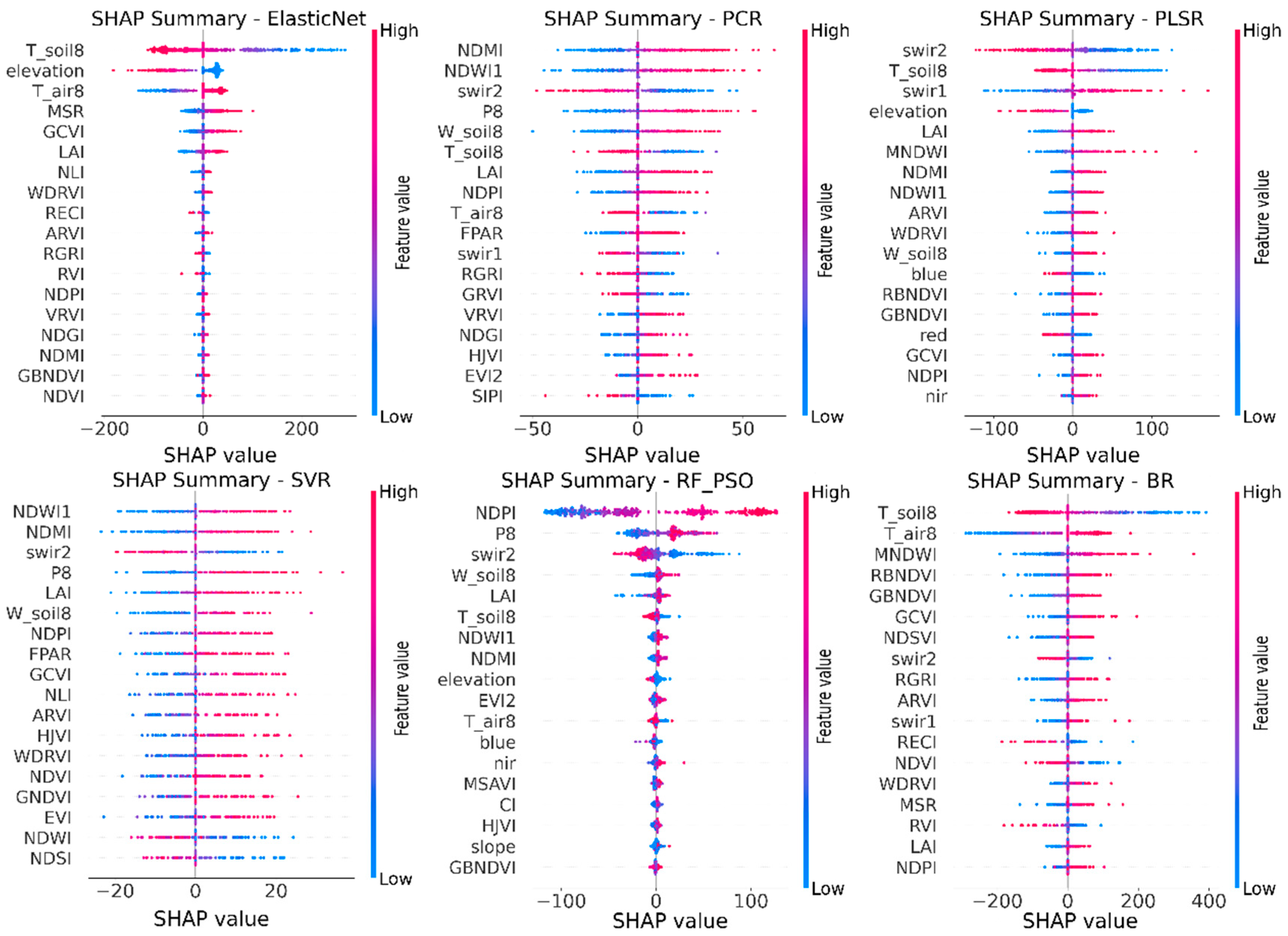

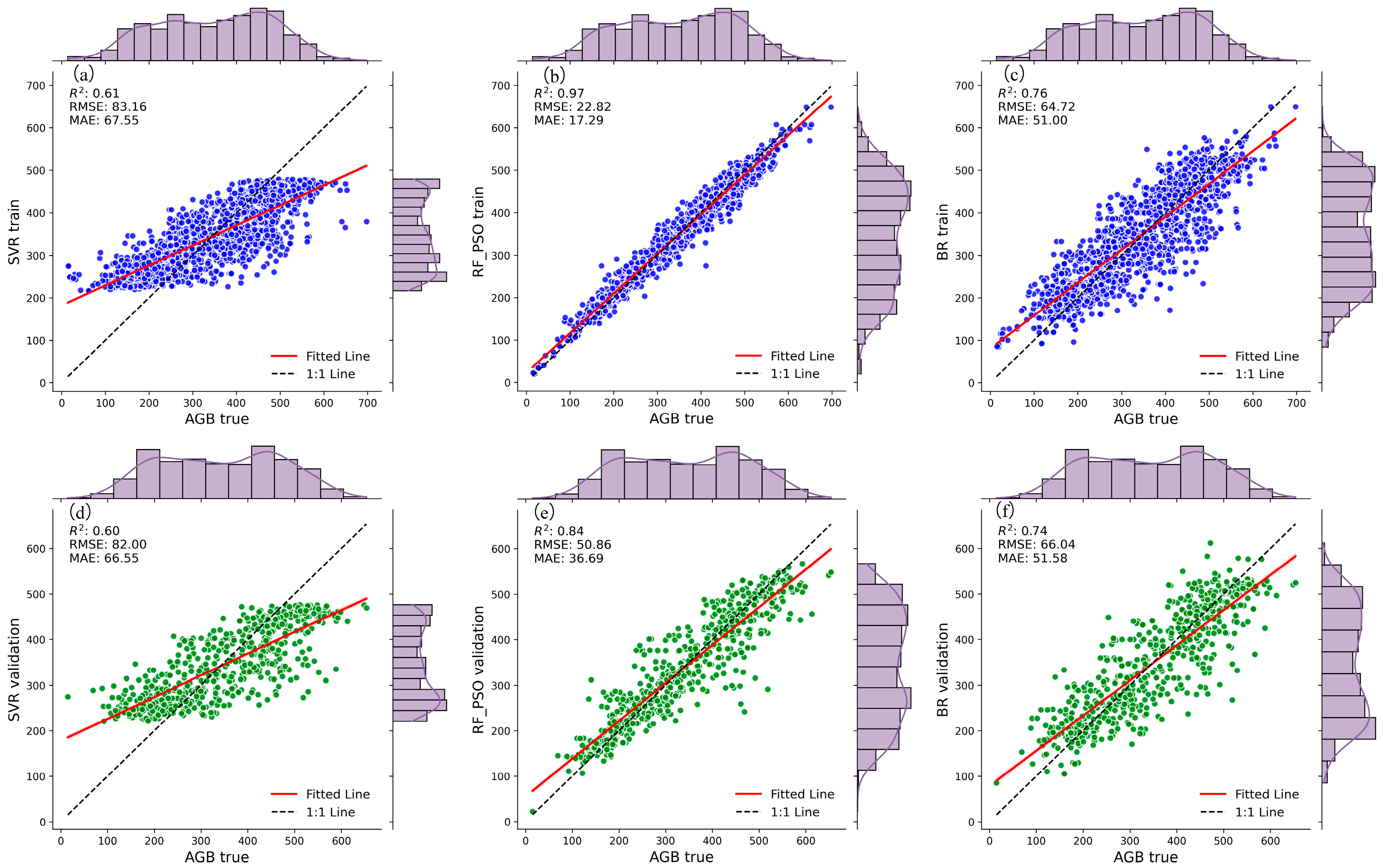
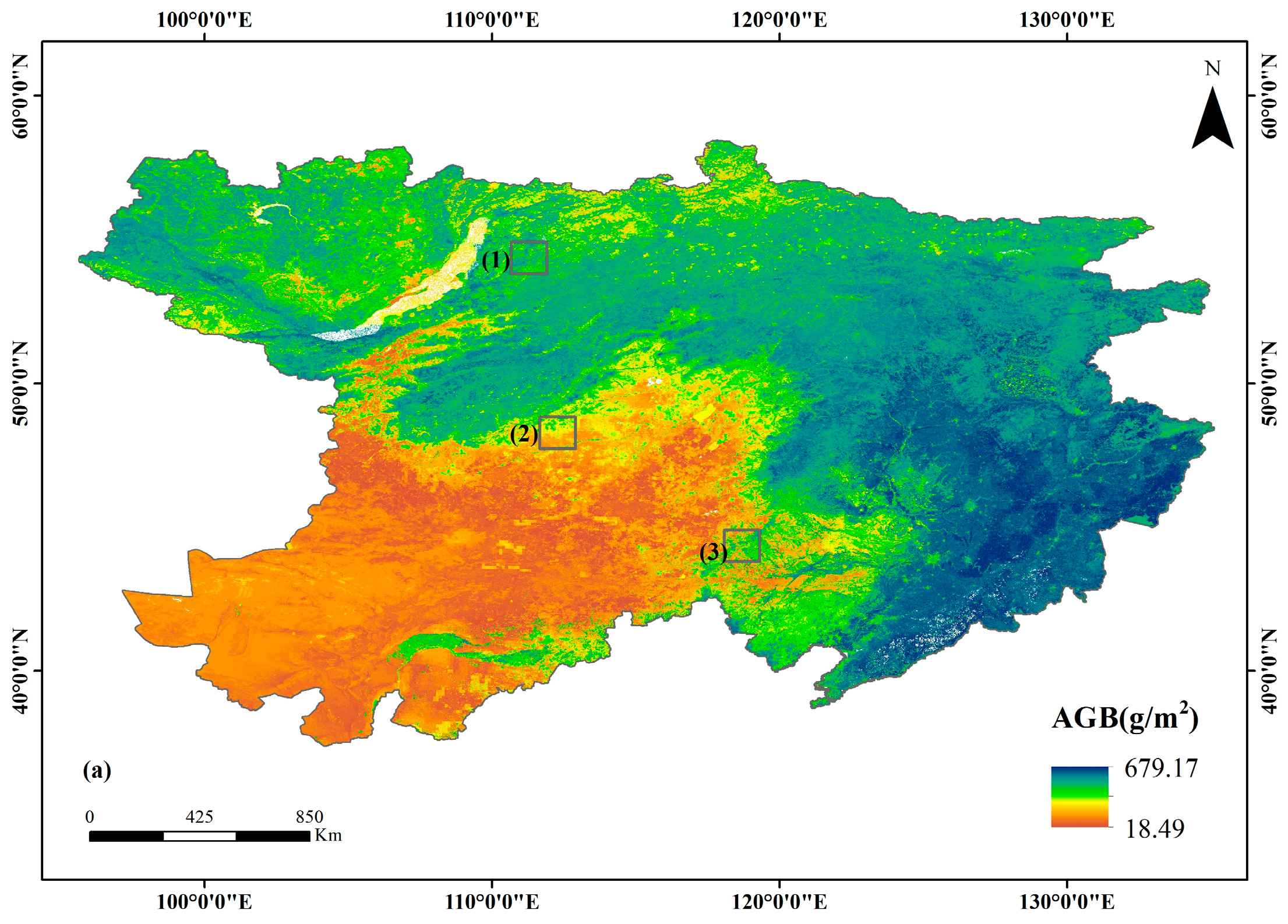
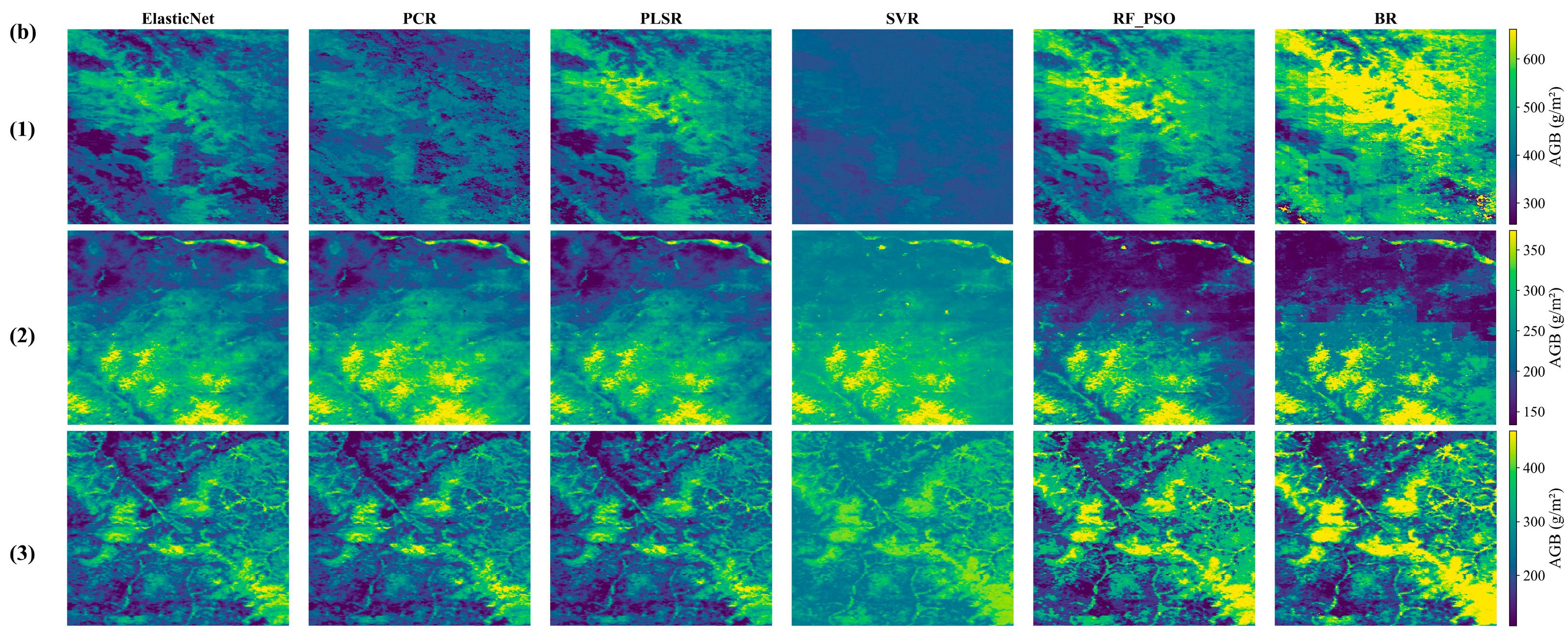

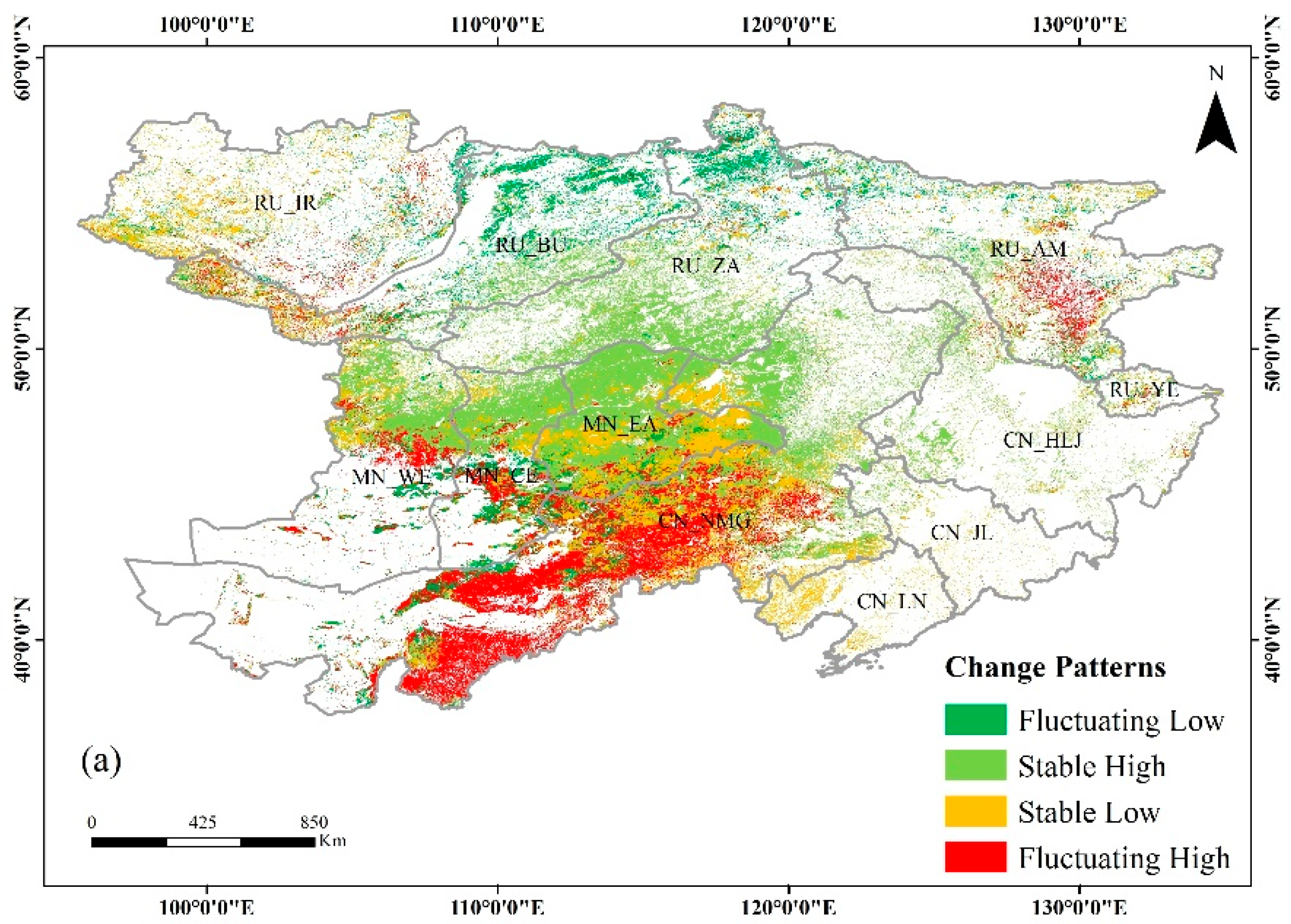
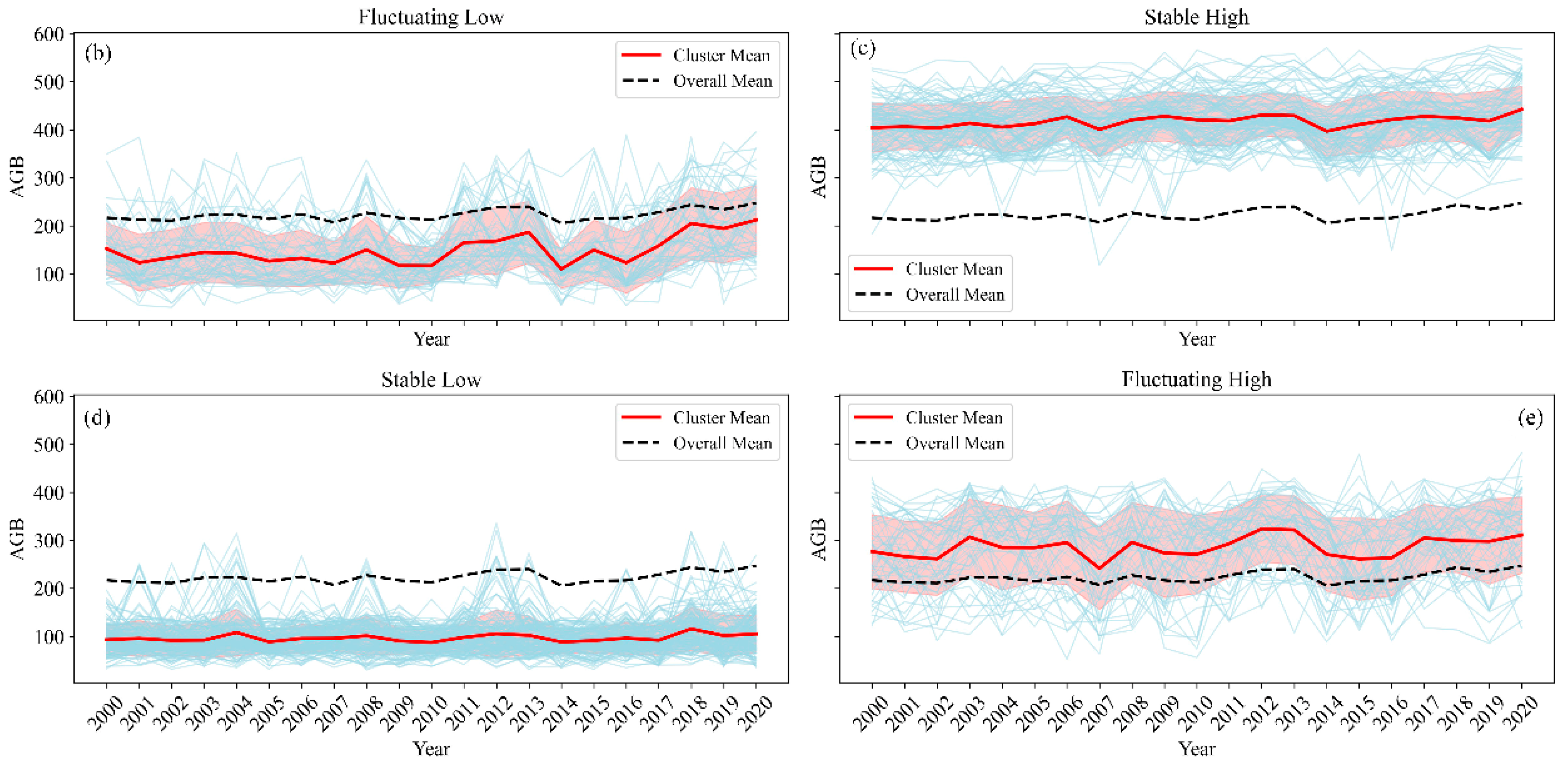
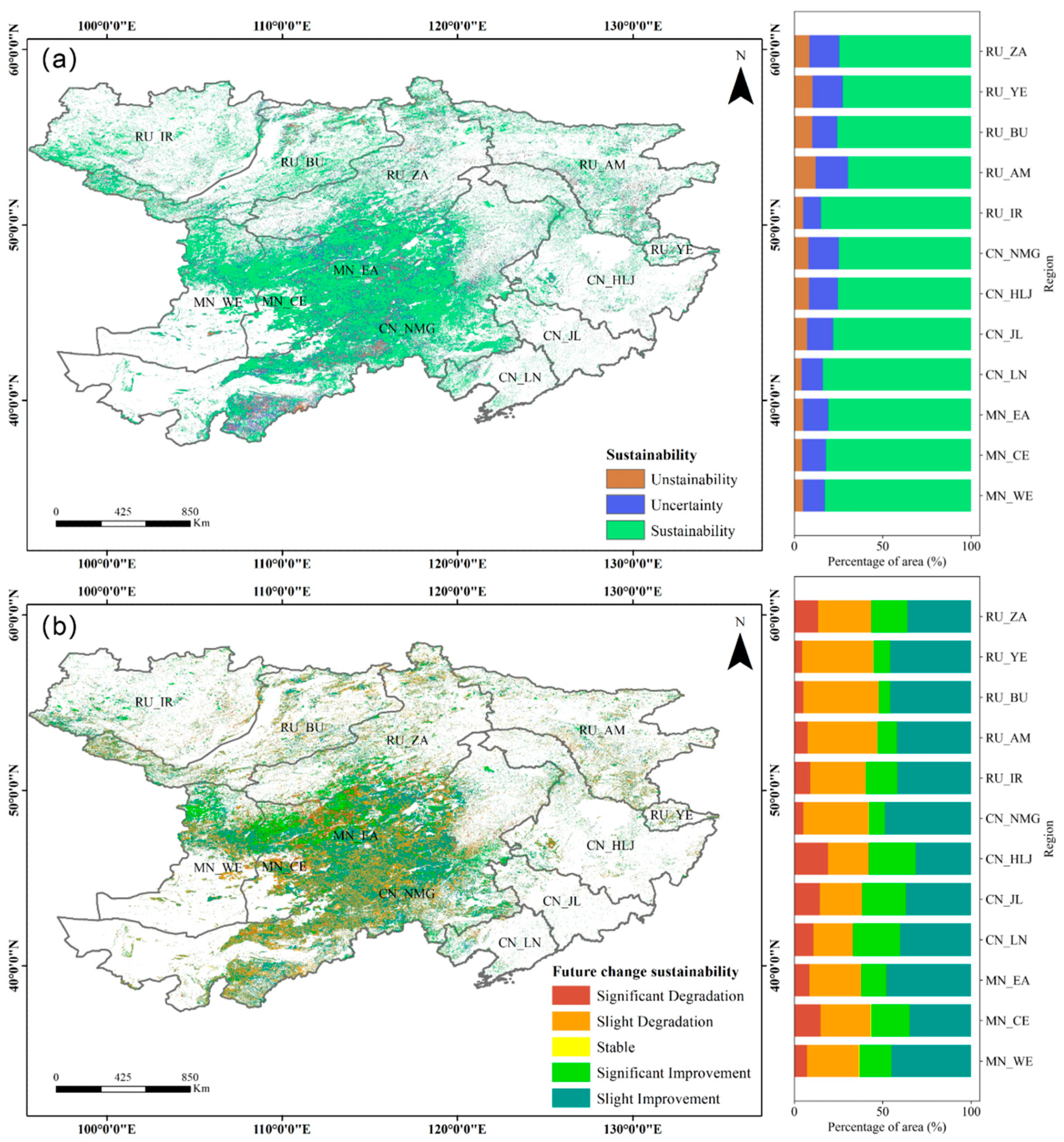
| Slope | Significance | Past Trend | Future Trend | ||
|---|---|---|---|---|---|
| 0 < H < 0.5 | H = 0.5 | 0.5 < H < 1 | |||
| Slope < −0.001 | p < 0.05 * | Severe↘ | Significant↗ | Uncertain | Severe↘ |
| Slope < −0.001 | p > 0.05 | Slight↘ | Slight↗ | Slight↘ | |
| −0.001 Slope 0.001 | p > 0.05 | Stable | Stable | Stable | |
| Slope > 0.001 | p > 0.05 | Slight↗ | Slight↘ | Slight↗ | |
| Slope > 0.001 * | p < 0.05 * | Significant↗ | Severe↘ | Significant↗ | |
| Model | R2 | RMSE | rRMSE | MAE | ||||
|---|---|---|---|---|---|---|---|---|
| Train | Validation | Train | Validation | Train | Validation | Train | Validation | |
| ElasticNet | 0.69 | 0.69 | 73.28 | 72.31 | 20.42% | 19.96% | 58.35 | 57.10 |
| PCR | 0.68 | 0.68 | 75.36 | 73.50 | 20.87% | 20.26% | 60.15 | 57.98 |
| PLSR | 0.69 | 0.68 | 73.36 | 72.62 | 20.45% | 20.22% | 58.18 | 57.23 |
| SVR | 0.61 | 0.60 | 83.16 | 82.00 | 23.25% | 22.60% | 67.55 | 66.55 |
| RF_PSO | 0.97 | 0.84 | 22.82 | 50.86 | 5.43% | 12.90% | 17.29 | 36.69 |
| BR | 0.76 | 0.74 | 64.72 | 66.04 | 17.29% | 17.97% | 51.00 | 51.58 |
Disclaimer/Publisher’s Note: The statements, opinions and data contained in all publications are solely those of the individual author(s) and contributor(s) and not of MDPI and/or the editor(s). MDPI and/or the editor(s) disclaim responsibility for any injury to people or property resulting from any ideas, methods, instructions or products referred to in the content. |
© 2025 by the authors. Licensee MDPI, Basel, Switzerland. This article is an open access article distributed under the terms and conditions of the Creative Commons Attribution (CC BY) license (https://creativecommons.org/licenses/by/4.0/).
Share and Cite
Ma, J.; Zhang, C.; Ou, C.; Qiu, C.; Yang, C.; Wang, B.; Mandakh, U. Estimation and Change Analysis of Grassland AGB in the China–Mongolia–Russia Border Area Based on Multi-Source Geospatial Data. Remote Sens. 2025, 17, 2527. https://doi.org/10.3390/rs17142527
Ma J, Zhang C, Ou C, Qiu C, Yang C, Wang B, Mandakh U. Estimation and Change Analysis of Grassland AGB in the China–Mongolia–Russia Border Area Based on Multi-Source Geospatial Data. Remote Sensing. 2025; 17(14):2527. https://doi.org/10.3390/rs17142527
Chicago/Turabian StyleMa, Jiani, Chao Zhang, Cong Ou, Chi Qiu, Cuicui Yang, Beibei Wang, and Urtnasan Mandakh. 2025. "Estimation and Change Analysis of Grassland AGB in the China–Mongolia–Russia Border Area Based on Multi-Source Geospatial Data" Remote Sensing 17, no. 14: 2527. https://doi.org/10.3390/rs17142527
APA StyleMa, J., Zhang, C., Ou, C., Qiu, C., Yang, C., Wang, B., & Mandakh, U. (2025). Estimation and Change Analysis of Grassland AGB in the China–Mongolia–Russia Border Area Based on Multi-Source Geospatial Data. Remote Sensing, 17(14), 2527. https://doi.org/10.3390/rs17142527






